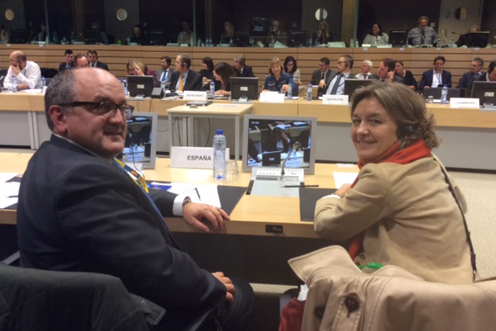At the close of the Council of EU Fisheries Ministers in Brussels
Spain has obtained favourable agreement for fish quota distribution in 2017, says Isabel García Tejerina
News - 2016.12.14
This agreement means that Spanish fishermen will be allocated an additional 41,000 tonnes of fish for next year, worth 44 million euros.
Isabel García Tejerina stressed that Spain has obtained a good agreement, after a disappointing initial proposal from the European Commission. She explained that "the policy promoted by the Government of Spain - based on the best possible scientific advice, rigorous control and defence of the sustainable use of resources - will lead to improved profitability and fishing conditions for the Spanish sector".
In this regard, the Spanish minister reiterated how this rigorous work has enabled Spain to obtain a favourable result after two days of intense negotiations at the Council of EU Fisheries Ministers.
Fishing possibilities
More specifically, the agreement reached this morning contains noticeably more moderate cut-backs than those initially proposed by the European Commission. In terms of northern stocks, those caught in EU waters (Gran Sol), the fishing possibilities for northern hake will be increased by 10% on 2016. This will lead to an all-time high, with 33,781 tonnes allocated to the Spanish fleet. In terms of monkfish, for which the initial proposal was highly restrictive, no changes will be made to the quota for 2016.
In terms of the southern stocks (Iberian waters), a noticeable improvement has been obtained on the proposal from the European Commission. The following results have been obtained: a 53.9% increase for monkfish; a minimal reduction of 1.5% to the 2016 quota for southern hake; and the initial 25% reduction to the quota for megrim has been lowered to 15%.
As regards Cantabrian anchovy, the same fishing possibilities will be maintained in 2017 (33,000 tonnes). A maximum catch of 12,500 tonnes has been set for Gulf of Cadiz anchovy, with the option for this to be revised during the course of the year based on stock status.
At the same time, horse mackerel fishing possibilities have been increased by 6.9% (North-west and Gulf of Cadiz) and by 5% for Norway lobster (Gulf of Cadiz). An initially proposed 45% reduction to western horse mackerel quotas was reduced to 23%.
Similarly, the agreement reached on Wednesday also includes increases to the quotas for ray (10% in Zones 8 and 9, and 5% in Zones 6 and 7), while fishing possibilities for pollock and whiting in the Bay of Biscay remain unchanged despite requests for reductions of up to 20%.
The regulations agreed by the Council of EU Fisheries Ministers also contain the quotas for blue whiting and Atlantic mackerel, previously negotiated with non-Member States (Norway in the case of blue whiting; and Norway, Iceland and the Faroe Islands in the case of Atlantic mackerel). Hence, the quota for blue whiting will increase by 80% and the quota for Atlantic mackerel will increase by 15%.
Similarly, it is worth that quotas have not been set for pelagic species in the Adriatic that were initially included in the proposal by the European Commission, meaning that a precedent for the Mediterranean has been avoided. Furthermore, the proposed restrictions on sea bass in the Bay of Biscay have been removed, which would have complicated fishing activity.





